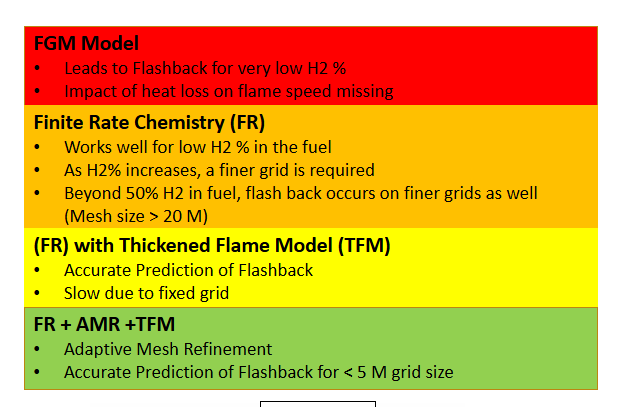TAGGED: #fluent-#ansys, cfd-combustion, flamelet
-
-
January 18, 2025 at 8:58 am
pistarty
SubscriberHello, I am a student using Fluent.
I am simulating CH4/H2 premixed gas turbine combustion using the partially premixed combustion model. However, I am facing an issue where the flame shape verified through the OH mass fraction differs slightly from experimental results. In the actual flame images, the outer flame root does not attach to the rim, but in the simulation, the outer flame root appears attached. Despite changing various settings, the flame shape in the simulation remains the same.
I would like to ask for advice on how to adjust the settings to replicate the experimental result, where the outer flame root does not stabilize at the rim. For reference, I am currently using the k-epsilon turbulence model, and I have also tried switching to k-omega, but the results did not change. The GRI 3.0 mechanism is being used as well.
Any advice would be greatly appreciated. Thank you. -
January 21, 2025 at 5:07 pm
jcooper
Ansys EmployeeHi:
The FGM model does not do so well with hydrogen flames. The more h2 is mixed into the fuel, the further off the predictions will be.
Hydrogen has a higher flame speed and wider flammability limit than methane, and this poses some modelling challenges. There is also significant differential diffusion of hydrogen due to its lower Lewis number (the ratio of thermal diffusivity to mass diffusivity). This differential diffusion leads to variations of the local equivalence ratio and, hence, reaction rates along the flame front. All of these make the FGM model, with its constant Lewis number assumption, a poor choice.
H2 flames exhibit something called flashback, which is very difficult to capture without a very fine mesh and models to artificially thicken the flame so that it can be resolved better on typical CFD meshes. (It is also helpful to be able to adapt the mesh to the movement of the solution.) In general. the more H2 in the fuel, the finer the mesh needs to be and the greater the need for auxiliary models. Below is a hierarchy of approaches that can be tried.I hope this helps.Regards,Judy
-
- You must be logged in to reply to this topic.


- air flow in and out of computer case
- Varying Bond model parameters to mimic soil particle cohesion/stiction
- Eroded Mass due to Erosion of Soil Particles by Fluids
- I am doing a corona simulation. But particles are not spreading.
- Issue to compile a UDF in ANSYS Fluent
- Guidance needed for Conjugate Heat Transfer Analysis for a 3s3p Li-ion Battery
- JACOBI Convergence Issue in ANSYS AQWA
- affinity not set
- Resuming SAG Mill Simulation with New Particle Batch in Rocky
- Continuing SAG Mill Simulation with New Particle Batch in Rocky

-
4512
-
1494
-
1386
-
1209
-
1021

© 2025 Copyright ANSYS, Inc. All rights reserved.








